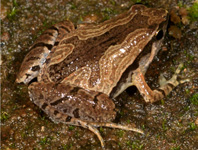Abstract
There are nearly 280 species of Liothrips listed from around the world (ThripsWiki 2016), all of them presumably feeding and breeding on the leaves of higher plants, and sometimes inducing or being associated with galls (Mound 1994). Despite this, for most of these species the identity of the plant species on which they are dependent is rarely known, and a particularly high proportion of the species are based on few specimens or even single individuals (cf Table 1). As a result, the identity of many of these named species continues to be in doubt. Modern identification keys are available only to the 23 Liothrips species known from Japan (Okajima 2006), the four European species known from Iran (Minaei & Mound 2014), and 14 species from Illinois (Stannard 1968). In contrast, the keys to 16 species of Liothrips from Brazil (Moulton 1933), to more than 80 species from Indonesia (Priesner 1968), and to 50 species from India (Ananthakrishnan & Sen 1980), are of little more than archival interest, in that they are based on few specimens with little allowance for intraspecific variation. Mound & Marullo (1996) listed over 80 Liothrips species from the Americas, although some of these are now placed in Pseudophilothrips (see Mound et al. 2010). That list included two homonyms of the Indonesian species Liothrips brevitubus Karny, one from Mexico and one from California. The homonym from Mexico is here recognised as applying to a species that in 2015 caused severe damage to a crop of Jatropha curcas in Chiapas. The objectives here are to provide a valid name for this pest, to facilitate its recognition among the 13 species of Liothrips recorded from Mexico (Table I), and also to replace the homonym from California.
References
Ananthakrishnan, T.N. & Sen, S. (1980) Taxonomy of Indian Thysanoptera. Zoological Survey of India (Handbook Series), 1, 1–234.
Anitha, K. & Varaprasad, K.S. (2012) Jatropha pests and diseases: an overview. In: Carels et al. (Eds.), Jatropha, Challenges for a New Energy Crop. Springer, New York, pp. 175–218.
https://doi.org/10.1007/978-1-4614-4806-8_10Asbani, N. & Sartiami, D. (2011) Physic Nut thrips diversity. Agrivita, 33, 257–264.
Cock, M.J.W. (1982) The biology and host specificity of Liothrips mikaniae (Priesner) (Thysanoptera: Phlaeothripidae), a potential biological control agent of Mikania micrantha (Compositae). Bulletin of Entomological Research, 72, 523–533.
https://doi.org/10.1017/S0007485300013705Hoddle, M.S., Mound, L.A. & Paris, D.L. (2012) Thrips of California 2012. CBIT Publishing, Queensland. Avaliable from: http://keys.lucidcentral.org/keys/v3/thrips_of_california/Thrips_of_California.html (Accessed 20 Dec. 2016)
Hood, J.D. (1909) Two new North American Phloeothripidae. Entomological News, 20, 28–32. [correction 20: 75]
Johansen, R.M. (1976) Dos nuevas especies de Tisanopteros Tubuliformes (Thysanoptera: Phlaeothripidae) del Pasto Para (Panicum sp.) de Tabasco, Mexico. Anales Del Instituto de Biologia. Universidad Nacional de Mexico, 45 (1974), 83–94.
Johansen, R.M. (1978) Nuevos Trips Tubuliferos (Insecta: Thysanoptera) de Mexico, II. Anales del Instituto de Biologia. Universidad Nacional de Mexico, 47 (1976), 69–82.
Johansen, R.M. (1981) Nuevos Trips Tubuliferos (Insecta: Thysanoptera) de Mexico VIII. Anales del Instituto de Biologia. Universidad Nacional de Mexico, 51, 347–362.
Karny, H. (1912) GallenbewohnendeThysanopterenaus Java. Marcellia, 1, 115–169.
Kono, T. (1964) Thysanoptera Studies 1. Three new Tubuliferous species (Thysanoptera, Phlaeothripidae). Occasional Papers Bureau of Entomology California, 4, 1–13.
Minaei, K. & Mound, L.A. (2014) The Liothrips--lineage of thrips (Thysanoptera: Phlaeothripidae) from Iran with the first record of micropterous morph of a Liothrips species Zootaxa, 3889 (1), 107–117.
https://doi.org/10.11646/zootaxa.3889.1.6Moritz, G., Mound, L.A., Morris, D.C. & Goldarazena, A. (2004) Pest thrips of the world– visual and molecular identification of pest thrips. Cd-rom published by Lucidcentral.org (Brisbane). ISBN 1-86499-781-8.
Moulton, D. (1929) New Mexican Thysanoptera. Pan-Pacific Entomologist, 6, 11–20.
Moulton, D. (1933) The Thysanoptera of South America III. Revista de Entomologia, 3, 227–262.
Mound, L.A. (1994) Thrips and gall induction: a search for patterns. In: Williams, M.A.J. (Ed), Plant Galls: Organisms, Interactions, Populations. Systematics Association Special Volume, 49, Clarendon Press, Oxford, pp. 131–149.
Mound, L.A. & Marullo, R.M. (1996) The Thrips of Central and South America: An Introduction. Memoirs on Entomology, International, 6, 1–488.
Mound, L.A., & Pereyra, V. (2008) Liothrips tractabilis sp. n. (Thysanoptera: Phlaeothripinae) from Argentina, a potential biocontrol agent of Weedy Campuloclinium macrocephalum (Asteraceae) in South Africa. Neotropical Entomology, 37, 63–67.
https://doi.org/10.1590/S1519-566X2008000100009Mound, L.A., Wheeler, G. & Williams, D.A. (2010) Resolving cryptic species with morphology and DNA; thrips as a potential biocontrol agent of Brazilian peppertree, with a new species and overview of Pseudophilothrips (Thysanoptera). Zootaxa, 2432, 59–68.
Okajima, S. (2006) The Suborder Tubulifera (Thysanoptera). The Insects of Japan, 2, 1–720. The Entomological Society of Japan, ToukaShobo Co. Ltd., Fukuoka.
Priesner, H. (1933) Neue exotische Thysanopteren. Stylops, 2, 145–156.
https://doi.org/10.1111/j.1365-3113.1993.tb00991.xPriesner, H. (1968) On the genera allied to Liothrips of the Oriental fauna II (Insecta-Thysanoptera). Treubia, 27, 175–285.
Resende, J.C.F., Gonçalves, N.P., Dias, M.S.C., Albuquerque, C.J.B. & Morais, D.L.B. (2012) Phytosanitary aspects of Jatropha farmingin Brazil. In: Carels et al. (Eds.), Jatropha, Challenges for a New Energy Crop. Springer, New York, pp. 219–237.
https://doi.org/10.1007/978-1-4614-4806-8_11Simmonds, H.W. (1933) The biological control of the weed Clidemia hirta, in Fiji. Bulletin of Entomological Research, 24, 345–348.
https://doi.org/10.1017/S0007485300031655Stannard, L.J. (1968) The Thrips, or Thysanoptera, of Illinois. Bulletin of the Illinois Natural History Survey, 29, 213–552.
ThripsWiki (2016) ThripsWiki - providing information on the World's thrips. <http://thrips.info/wiki/Main_Page> [3.xi.2016]
Watson, J.R. (1923) Synopsis and catalog of the Thysanoptera of North America. Bulletin of the Agricultural Experiment Station, University of Florida, 168, 1–100.

